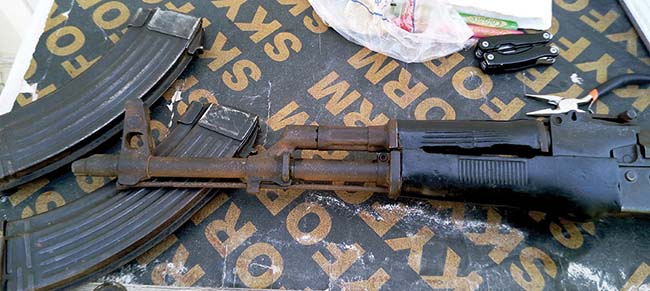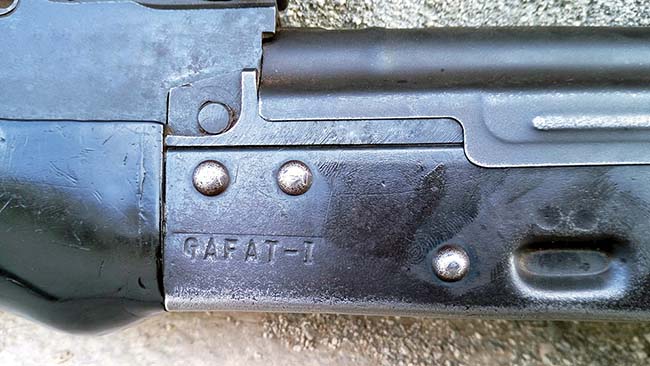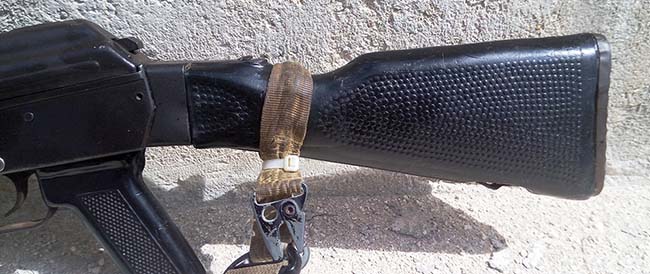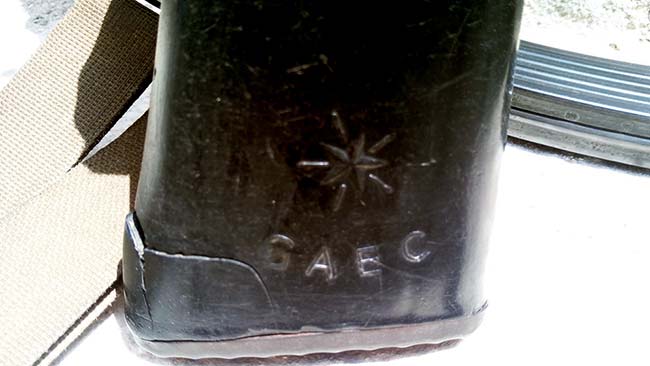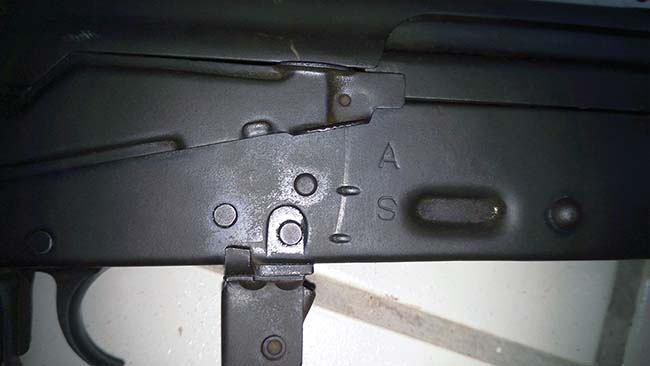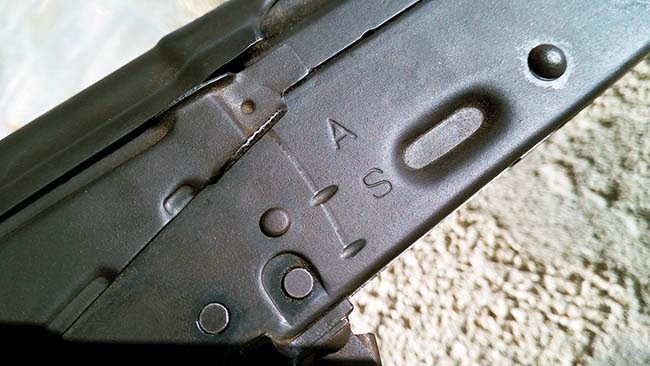ABOVE: Ethiopian AKM, right-side view.
An Ethiopian Surprise
In the age of Google, Facebook, Reddit and all the AK-47-centered internet forums, you would not really think that some AK variants are still unknown to the general public.
These days, if one wants to learn about different types of Kalashnikovs, all one needs to do is open a browser. Forums, pictures and even special identification charts abound.
I personally was very lucky—a good friend of mine, Pavel Pticin, owns the finest collection of foreign-made AKs in Russia. Thanks to him, I had at least some idea about most foreign AK variants. Also, working as an armorer in Iraq, Afghanistan and Somalia, I had a chance to inspect and repair several thousand AKs from different countries.
People love to argue about which country made the best quality AKs. I get this question very often, and the answer is always the same, “I don’t really know.”
To answer this question with any certainty and credibility, one would need to get a batch of AKs made in every country in question and conduct extensive MIL-SPEC testing. No one will ever pay for that.
But at least now I have an answer to another, less popular question: “What are some of the worst AKs you’ve ever seen?”
After working with Kalashnikov rifles in Russia for over a decade and doing some overseas armorer gigs, I really did not expect to see anything new when I was heading to Somalia for the first time. Needless to say, I was dead wrong.
Mystery AK
I landed in Mogadishu in a surprisingly nice airport, got through security and jumped into an armored Land Cruiser, which seemed to be the most popular choice of transportation for everyone who was on the same flight with me.
We just got to the base, and I was checking into the camp and getting my badge when a guard walked in with a very strange AK variant.
It was a stamped AKM with weird black plastic furniture. The handguard looked a bit like the East German one, with vertical checkering, but the color was definitely not right. The buttstock also had distinct East German “pebble grain” texture, which you can see on some MPI-KMs, but again, it was black.
All my weariness from the 15-hour flight with two connections was gone. I really wanted to know what it was.
I figured that trying to take the gun from a complete stranger is not a very smart idea, so I had to wait until the next day to take a closer look.
The next day the guards gave all their weapons to me for inspection, and I saw that AK again. One other rifle was also made by the same manufacturer. It actually had quite a few distinct markings and features, so identification itself was not so difficult after all.
On the left side of the receiver, the weapon had an inscription of the word, “GAFAT-I,” which immediately solved the mystery.
Gafat Armament Engineering Complex is one of the most prominent factories of the Ethiopian military-industrial complex.
Some people might smile when they hear “Ethiopian military-industrial complex” but really, there is nothing to laugh about. Ethiopia has quite a few very capable factories producing small arms, ammunition, mortars, repairing and upgrading military vehicles and even tanks.
Officially, Gafat Engineering Factory was established in January 1986, but the village that gave the name to the company actually had its first firearms manufacturing facility as early as 1866.

The first question that came to my mind was: “How exactly did Ethiopia get the transfer of technology for AKs?”
They certainly did not get it from Russia (believe me, I know). Maybe it was China? China transferred technology to Albania, Iran and Sudan, why not Ethiopia? However, the gun had no Chinese features, such as fully enclosed hooded front sight, spike bayonet or L&D markings on the selector, etc.
On the first glimpse, the gun looked like a standard stamped AKM with smooth dust cover. However, as I looked inside, the origin of the gun became clear, yet very surprising.
As we all know, the easiest way to identify an AK is to look at selector markings, rear sight and factory identification marks.
The selector markings did not match any manual that I had. The full-auto setting was designated as “A” (I am assuming “automatic”) and semiauto as “S” (self-explanatory).
The safe position of the selector, as it usually is with most AKs except for Romanian variants, had no mark.
Another Ethiopian gun had Roman numeral “I” for semiauto fire and an infinity symbol for fully automatic. At first, I thought that it was a Hungarian-made weapon, since they also use the infinity symbol for full-auto.
The rear sight was even more unusual. First of all, it was only graduated up to 800 meters, with all the AKMs always having a rear sight graduated up to 1000 meters.
Again, none of that was in any identification manual that I knew of. Nevertheless, deep down I felt that I remembered something about guns with the Roman numeral III on the rear sight.
There were no visible factory markings on the trunnion, just a serial number.
Right above the magazine release there was an additional rivet inside a small indentation—a very unusual feature.
The quality of the guns clearly was not very good. But one weapon looked particularly gruesome. The front trunnion with barrel assembly was violently wobbling in the receiver. Without any effort, you could move the barrel up or down a quarter of an inch or so. The rivets looked horrible.

The weapon was easily closing on a “field” headspace gauge, which also did not inspire much confidence. Repairing this rifle without any equipment or spare parts was impossible, so I decided to just use it for much needed parts.
As I disassembled it, I noticed even more features that made this rifle stand out. The trigger mechanism had no full-auto retarder, typical for any AKM-type rifle.
As I tried to use the Ethiopian trigger to repair a different weapon I finally noticed that it was a double hook—double hook trigger; selector and rear sight markings; and additional rivet over trigger guard.
Mystery Solved
I finally remembered one very interesting and unique article by Frank Iannamico that was published in Small Arms Review in February 2010: “AK Rifles of the Democratic People’s Republic of (North) Korea.” In my hands, I had an Ethiopian copy of the North Korean Type 68 assault rifle.
North Korea was given the technology of AK production by the USSR in the 50s and 60s and was not allowed to transfer it to anyone else. Officially, they never built any AK factories anywhere in the world outside of their own country. At least that is what we thought.
The United Nations and international community were looking for proof of illegal collaboration with North Korea for years. However, all they really had to do to prove it was to field strip any Ethiopian AK.
The history of AKs is a fascinating thing. Sometimes in just researching a rivet or a small indentation on the receiver, you can learn a lot about modern political history and international relations.
Editor’s Note: Vlad worked for Kalashnikov Concern among other AK groups in Russia and has been a valuable asset to the AK community as he travels to various hot spots as an armorer contractor. I visited the Gafat Factory in Ethiopia several years ago, and indeed the machines were North Korean and from the old Czechoslovakia. The factory was well-designed with good work flow, and the products looked well made. There were five variants of East-German-looking AKM rifles and one PSL clone coming off the lines. The possibility of “Lunchbox” AKMs is more of a probability, and we’ve been trying to track where these show up—it seems in South Sudan, Somalia and Eritrea right now. Thanks to Vlad for his observations and photos.




